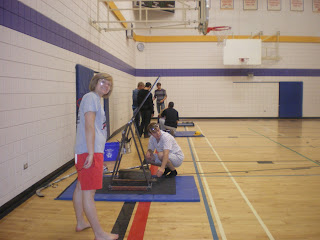After spending some class time and lots of spare/lunch hours working on the bridge, it was displayed in the case at the school entrance, giving it a couple days to dry and harden.
 |
| Before Drying |
Competition Day was Friday January 21.
My team's bridge was very successful - definitely exceeding our expectations.
It was awarded the class-voted "Most Appealing Design", held the most mass overall (6.5kg) , and the most mass supported per gram of spaghetti (24.3grams of mass/gram of bridge).
Our bridge could have supported more, but we jumped from 6.5 kg to 10.0 kg, since we had already exceeded the required mass and were then aiming for a record.
 |
| Apparently I was a bit nervous! |
 |
| Adding the Masses |
1. What part of the process did you find the most rewarding? Why?
I feel that the most rewarding part of the process was when our bridge was finally complete. There were a lot of days where we weren't exactly sure what we were doing or if we were going to finish. To see the completed bridge, not only finished but fairly well done, was the most rewarding (and relieving) part of the process.
2. Identify the specific strengths of your bridge design.
I believe that the base of our bridge was the strongest part of our design. It was thick, with each layer interlocked with the others. Everything was well connected with lots of glue. It was a time consuming process, but it paid off. In the end, it was the center of the base that broke, but the rest of it did not even crack.
Our "spaghetti sticky-tac" was also a strong invention. After using a leaky water container as a weight to keep our spaghetti from warping, we accidentally created a mushy mess, that when mixed with glue, made a wonderful supportive adhesive, that dried very hard. It came in very handy!
3. Identify any changes that you would incorporate to refine your present design. Based upon your observation during the competition, what effect might these changes have on your bridge?
If I could have made any refinements, I would have strengthened the center of the bridge. We built a hole into the base so that we could place the mass hanger on the base. The narrow sides were the weak spot that ended up breaking. We could have coated those sides with our spaghetti sticky-tac to add more thickness, strength, and support. If we had more time, we could have refined the supports, making them more effective as well. We did have some mass to play with, but we did not have the time. The extra support system also could be completely redesigned to support more mass (whether they were thicker, or had different placement).
Final Thoughts:
Time is definitely a necessity for this project, because things need to dry in between every step!
Have lots of glue - just as much will go on your hands as the bridge!
Awesome discoveries are usually accidental!
Don't stress too much - have fun with projects like these!




































